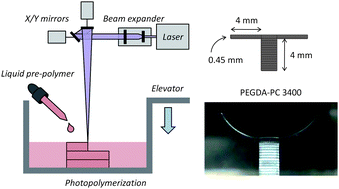Multi-material bio-fabrication of hydrogel cantilevers and actuators with stereolithography†
Abstract

* Corresponding authors
a Department of Bioengineering, University of Illinois at Urbana-Champaign, Urbana, Illinois, USA
b Department of Chemical and Biomolecular Engineering, University of Illinois at Urbana-Champaign, Urbana, Illinois, USA
c Department of Electrical and Computer Engineering, University of Illinois at Urbana-Champaign, Urbana, Illinois, USA
d Department of Mechanical Engineering, University of Illinois at Urbana-Champaign, Urbana, Illinois, USA
e
2000 Micro and Nanotechnology Laboratory, MC-249, University of Illinois at Urbana-Champaign, 208 North Wright Street, Urbana, Illinois, USA
E-mail:
rbashir@illinois.edu
Fax: +1 (217) 244-6375
Tel: +1 (217) 333-3097

 Please wait while we load your content...
Something went wrong. Try again?
Please wait while we load your content...
Something went wrong. Try again?
V. Chan, J. H. Jeong, P. Bajaj, M. Collens, T. Saif, H. Kong and R. Bashir, Lab Chip, 2012, 12, 88 DOI: 10.1039/C1LC20688E
To request permission to reproduce material from this article, please go to the Copyright Clearance Center request page.
If you are an author contributing to an RSC publication, you do not need to request permission provided correct acknowledgement is given.
If you are the author of this article, you do not need to request permission to reproduce figures and diagrams provided correct acknowledgement is given. If you want to reproduce the whole article in a third-party publication (excluding your thesis/dissertation for which permission is not required) please go to the Copyright Clearance Center request page.
Read more about how to correctly acknowledge RSC content.
 Fetching data from CrossRef.
Fetching data from CrossRef.
This may take some time to load.
Loading related content
